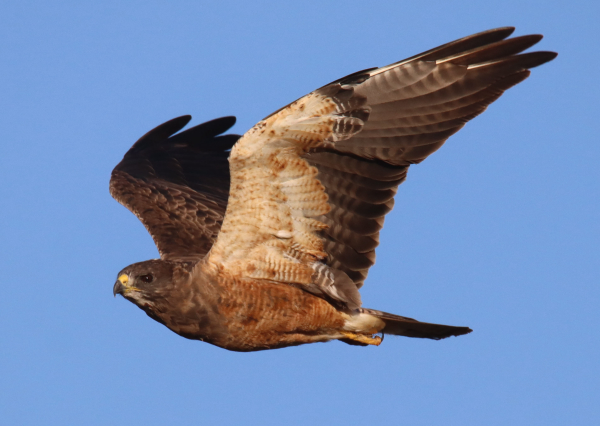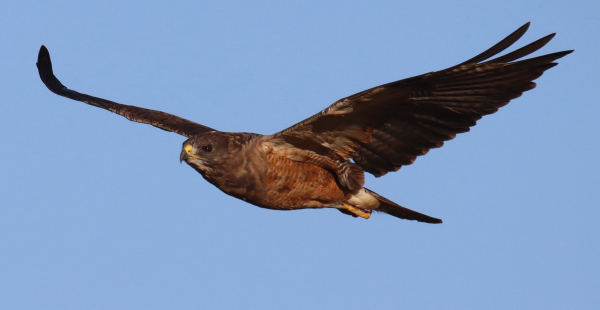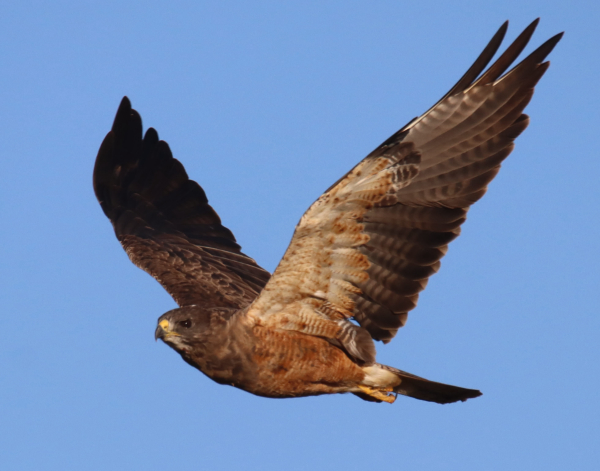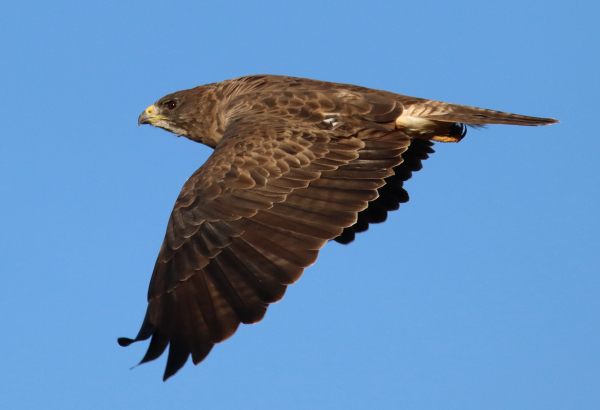September is a prime raptor migration period, making the coming days an exciting time to get into the field with your camera. Any local drive should turn up a couple birds of prey to view and potentially photograph. The species you find will depend on the region of the continent you live in, but birds of prey always provide the potential for good photographs. Toward the end of my birding drive Friday, I viewed a Swainson’s Hawk perched near the edge of a hayfield, but I opted to check on a hawk I notice perched on the top of a hill a quarter-mile to the west. I could only see its silhouette from my vantage point, but was able to follow a grass-covered abandoned road to reposition between the sun and the bird so I could get a better look at the hawk during peak evening light at 7pm.
The raptor turned out to be a rufous morph Swainson’s Hawk I have been interested in photographing; the other Swainson’s was probably her mate, and they raised 3 fledglings, 1 of which appeared to be perched on a hill to the south. This time, rather than trying to inch into position as close as possible, I stopped farther away from the hawk than usual. It allowed me to exit my vehicle on the top of the same hill where the hawk was perched with its back to the sun. Likewise, I stood with my back to the sun, facing the rufous hawk. As it looked over its shoulder in my direction, I pre-focused my camera lens on the hawk to be prepared in case it might fly, but I really wasn’t close enough to take the best quality of photos. Not alarming the hawk felt right.

Suddenly, the hawk launched itself into flight, punctuated by a loud scream that pierced the still evening. I knew this territorial rufous hawk was vocal and reveled at the sound of its wild cry. It may have been that territorial fervor that made the hawk fly toward me rather than away from my camera. I could not have designed a better flight route for the grand raptor as it flew ever closer to me at an angle that bathed it in the sunlight of the summer’s eve. The sunlight brightened the markings of each feather while eliminating most shadows, and you can see the reflection of the sun in the hawk eyes – perfecto.
I began taking photos of the hawk as soon as it took flight, and the first 2 images showed the hawk’s curved beak opened wide as it called – Swainson’s calls are truly screams. Usually such flights happen all too fast, but this one seemed to take place in slow motion, which permitted me to be more relaxed as the raptor winged toward me – wings up, wings down, and all points in between as it muscled its way in my direction. What I was seeing through my lens was at once exciting and fulfilling – just the fact that the hawk would fly toward me rather than away was a thrill, yet I was reacting in a moderated fashion rather than in a tensed up jerky way, which happens when the action moves too fast.

When the rufous hawk passed the good sunlight line, as it passed by me low and close, I quite expected it to circle me; it just seemed like that kind of flight, that kind of interaction. But I watched longingly as the regal Swainson’s Hawk winged toward the sun, dropping below my hilltop stance. Even so, I think part of my nonchalance about this hawk photo opportunity led to part of the success of the series of photos that resulted. Rather than trying to force a photo op by getting closer and perhaps making the bird flee in response to my approach, by keeping my distance the hawk really dictated the action and the outcome of this interaction.
Its seemingly slow climbing flight in my direction was angled perfectly to show the details of its flight, including the aerodynamics of this long-winged Buteo hawk, while also showing the raptorial features of the hawks hooked beak and intense eyes. But even beyond the Swainson’s larger qualities, it showed the intricacies of the rufous belly feathers, even showing the faint delineation in color between the rufous feathers and its brown head and breast plumage. I couldn’t have enjoyed the experience more, and I don’t think I could have taken any better photos of this faire bird – timing, luck, positioning, and a bit of initial indifference seemed to have worked in concert.

A Historic Context
This rufous hawk and I actually have history: I took my first photo series with her when she appeared as the first Swainson’s Hawk to arrive in the area during April of 2017, my first spring after returning to the Dakota outback from southern California. This uniquely colored hawk, unique among hawks in this area, has returned to her nesting territory 6 miles south of my office each spring ever since with a normally colored adult male, possibly the same bird although it’s impossible to tell because all normally colored Swainson’s in the area are indistinguishable.
That said, perhaps our long-time connection had something to do with the hawk’s flight in my direction, rather than away from me – but that’s probably a too-human angle of thought. It all happened quickly after I parked on the hilltop, and the flight took just a minute of time – a minute I will enjoy recounting each time I see one of the resulting photos.

So much about bird photography is spontaneous; suddenly, there’s a bird; you raise your camera and focus, it acts or reacts, and you do or don’t get some fine fotos. It’s never a sure thing, but we do what we can to make the opportunity successful. We have the right equipment, we know how to use it, we have the experience to react and adjust to each photo situation. We have our camera settings ready for action under the current conditions, and even before these things, we have selected the best time of day to be in the field, camera in hand, or at least within reach, and we hope the birds we try to photograph accept us on some level, hopefully not fleeing the scene.
But most important, it’s up to us as birders to make time to get out there, search for photogenic birds, and do what you can do to make the most out of each photo opportunity, all the while keeping the bird’s well-being foremost in mind, trying not to interrupt it or other birds around it. And then there is luck; always bring some luck in your pocket too – Good Luck!
Article and photographs by Paul Konrad
Share your bird photos and birding experiences at editorstbw2@gmail.com